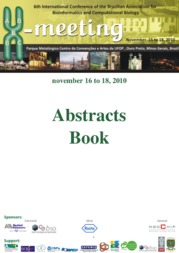A brazilian soybean database.
A brazilian soybean database.
Author(s): NASCIMENTO, L. C.; COSTA, G. G. L.; MEYER, L.; BINNECK, E.; RODRIGUES, F.; KULCHESKI, F. R.; MARGIS, R.; KIDO, E. A.; MARCELINO, F. C.; NEPOMUCENO, A. L.; ABDELNOOR, R. V.; PEREIRA, G. A. G.; CARAZZOLLE, M. F.
Summary: Soybean is a legume with large economic importance in the international market, with a world production of almost two hundred and ten million tons in the 2008/2009 harvest. Brazil appears as the second largest producer, with about twenty-five percent of the world production. In 2007, the Brazilian Soybean Genome Consortium (GENOSOJA) was established with the goal of integrating several institutions currently working with soybean genomics in Brazil. The project has an initiative to search for new treats to improve the soybean production process, emphasizing in stresses that affect the national production, like the occurrence of droughts, pests attacks and the Asian Rust disease. Among the objectives of GENOSOJA is the creation of a relational database, integrating the results achieved by different methodologies utilized in the project. In the GENOSOJA context, we created a brazilian soybean database, integrating: (1) public data consisting of genome and predicted genes from JGI, an assembly of 1,276,813 of NCBI ESTs from several cultivars and 4,712 full-length cDNA sequences from one japanese cultivar; and (2) private data consisting of (i ) three cDNA libraries explored by SuperSAGE methodology, resulting in 4,373,053 tags of 26 bp, (ii ) 22 cDNA subctrative libraries from several brazilian cultivars under different stresses and (iii ) several libraries of soybean microRNAs under eight conditions and size between 19 and 24 bp. All these data were sequenced using Solexa/Illumina sequencing technology. This database offers to the users some features, including keywords searches, statics comparisons, automatic annotation, gene ontology classification and gene expression of the genes under certain conditions. All data are storage in a Fedora Linux machine, running the MySQL database server. The web interface is based in a combination of CGI scripts using Perl language (including BioPerl module) and the Apache Web Server.
Publication year: 2010
Types of publication: Abstract in annals or event proceedings
Unit: Embrapa Soybean
Keywords: Soybean
Observation
Some of Embrapa's publications are published as ePub files. To read them, use or download one of the following free software options to your computer or mobile device. Android: Google Play Books; IOS: iBooks; Windows and Linux: Calibre.
Access other publications
Access the Agricultural Research Database (BDPA) to consult Embrapa's full library collection and records.
Visit Embrapa Bookstore to purchase books and other publications sold by Embrapa.

